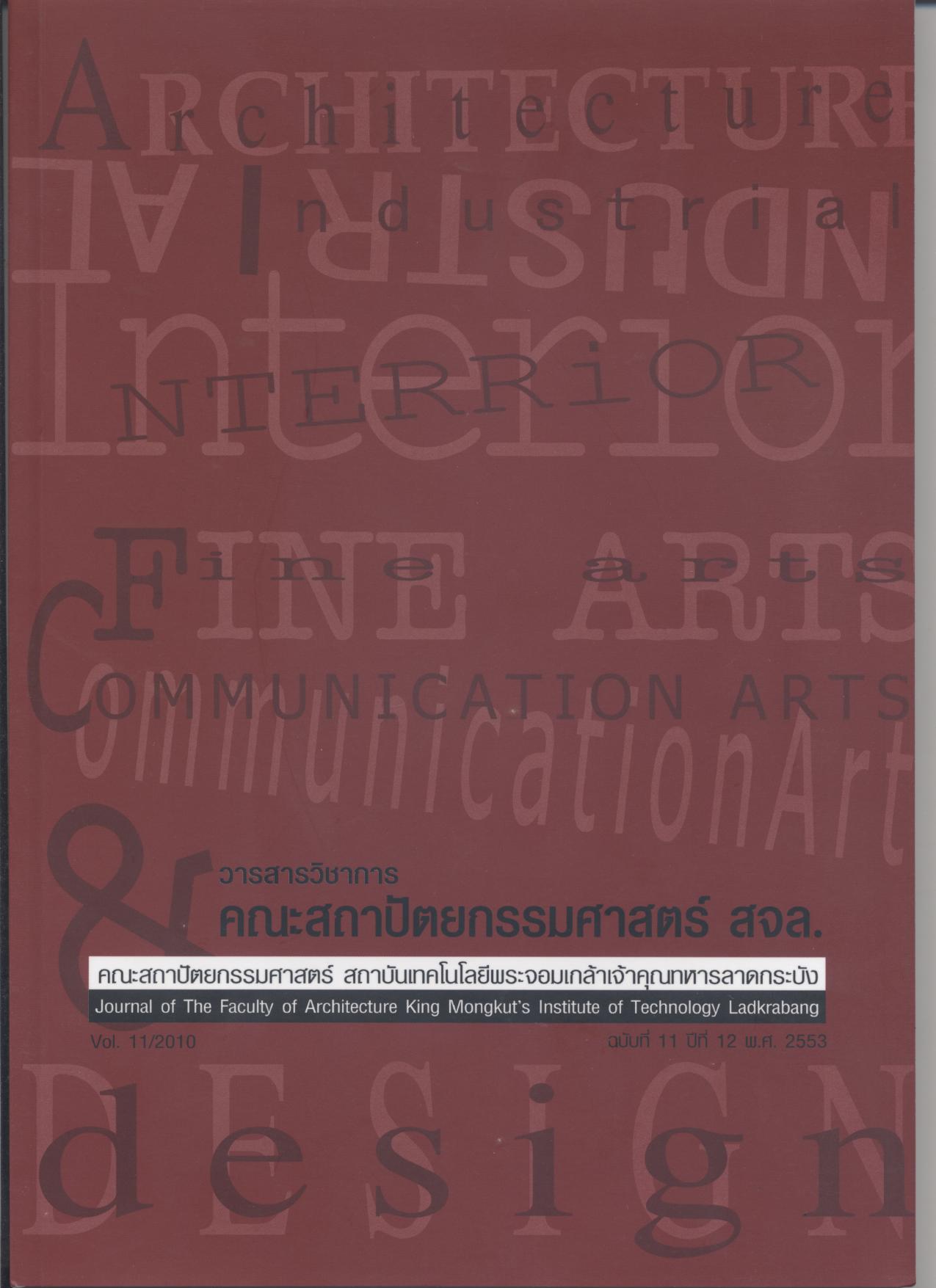การศึกษารูปแบบเทคโนโลยีการก่อสร้างอาคารบริเวณพื้นที่ชุ่มน้ำ กรณีศึกษา ชุมชนเชื่อมสัมพันธ์ แขวงแสมดำ เขตบางขุนเทียน กรุงเทพมหานคร
Main Article Content
Abstract
บทคัดย่อ
วัตถุประสงค์หลักของการวิจัยนี้คือการศึกษารูปแบบเทคโนโลยีการก่อสร้างอาคารภายในชุมชนเชื่อมสัมพันธ์ซึ่งมีลักษณะเป็นพื้นที่ชุ่มน้ำเพื่อให้ได้มา ซึ่งข้อสรุปที่แสดงถึงเทคโนโลยีการก่อสร้าง ลักษณะทางกายภาพ กรรมวิธีในการก่อสร้างรวมถึงความสัมพันธ์ของเทคโนโลยีการก่อสร้างอาคารภายในชุมชนกับสภาพพื้นที่ชุ่มน้ำ ซึ่งชี้ให้เห็นถึงภูมิปัญญาท้องถิ่นที่ประยุกต์การก่อสร้างอาคารให้สอดคล้องกับสภาพภูมิประเทศของชุมชน โดยมีรายละเอียดขั้นตอนประกอบด้วยการเก็บข้อมูลภาคสนามที่ใช้การสำรวจอาคารพร้อมทั้งสอบถามสัมภาษณ์ช่าง และเจ้าของอาคารภายในชุมชนแล้วจึงนำผลมาวิเคราะห์เพื่อให้ได้มาซึ่งผลลัพธ์ตามวัตถุประสงค์ดังกล่าว
ผลการวิจัยพบว่ารูปแบบเทคโนโลยีการก่อสร้างอาคารภายในชุมชนเชื่อมสัมพันธ์เป็นการใช้เทคนิคการก่อสร้างระดับกลางคือใช้เครื่องมือทั่วไปหรือเครื่องจักรทุ่นแรงที่ไม่มีความซับซ้อนมากนักในการใช้งานทว่าต้องอาศัยทักษะประสบการณ์ในเชิงช่างควบคู่กันกับการเลือกใช้วัสดุที่ผลิตด้วยเทคโนโลยีการผลิตทั้งในระดับล่างที่เป็นวัสดุที่มาจากธรรมชาติไม่ต้องผ่านการแปรรูป เช่น เสาเข็มไม้สน และระดับกลางจนถึงระดับสูงคือวัสดุสังเคราะห์ที่ผ่าน
กระบวนการทางอุตสาหกรรม ในส่วนของความสัมพันธ์ระหว่างเทคโนโลยีการก่อสร้างกับสภาพพื้นที่ชุ่มน้ำได้สะท้อนออกมาในส่วนฐานรากและพื้นอาคาร ซึ่งเป็นองค์ประกอบที่สัมผัสกับน้ำและความชื้นตลอดเวลาจึงเป็นเหตุให้ช่างในชุมชนเลือกใช้วัสดุที่ผลิตด้วยเทคโนโลยีการก่อสร้างระดับสูงที่มีคุณสมบัติสอดคล้องกับสภาพดังกล่าว
ประโยชน์ที่ได้จากการวิจัยทำให้ทราบถึงรูปแบบเทคโนโลยีการก่อสร้างของชุมชนเพื่อนำไปใช้เป็นข้อมูลในการออกแบบและก่อสร้างอาคารภายในชุมชนเชื่อมสัมพันธ์ซึ่งมีโครงการที่จะปรับปรุงวางแผนพัฒนาระบบสาธารณูปโภคและฟื้นฟูซ่อมแซมอาคารภายในชุมชน รวมถึงใช้สำหรับคาดการณ์เทคโนโลยีการก่อสร้างที่เหมาะสมสำหรับพื้นที่อื่นซึ่งมีสภาพเงื่อนไขคล้ายคลึงกันนี้
คำสำคัญ: เทคโนโลยีการก่อสร้าง , ภูมิปัญญาท้องถิ่น , พื้นที่ชุ่มน้ำ
Abstract
The main objective of this research is to study patterns of building construction technology within Chuam-sampan community. The community, which is the nature of wetland in order to get the conclusion that represents structuring technology. Physical processes in construction, including the connection of building construction technology in community and the wetland, which show the application of local wisdom structuring in accordance with the terrain of community. The process includes detailed data on the exploration field and interviews with both technicians and building owners in the community, and then the resulting analysis to derive the results based on such objectives.
The research found that the patterns of building construction technology within Chuam-sampan community is Intermediate construction technology that use a common tool or non-complex machine but require skilled technicians experienced and use traditional or low material technology which come from nature and not transform such as pine wood stake also Intermediate material technology until high material technology that all synthetic matter under industrial process. The dealing with structuring technology and the wetlands is reflected in the foundation and floor building that touch the water and moisture all the time. Therefore, the technician in community selects to use the high material technology that has quality compatible with the condition.
Benefit from the research made aware about the patterns of building construction technology and use information in the design and structuring projects within the community. This project wills improving, planning and developing the public utility system rehabilitates and repair building in the community. Moreover for estimate the appropriate construction technology for other areas which have similar condition as well.
Keyword: Construction technology, Local wisdom , Wetland
Article Details
This work is licensed under a Creative Commons Attribution-NonCommercial-ShareAlike 4.0 International License.
Copyright Transfer Statement
The copyright of this article is transferred to Journal of The Faculty of Architecture King Mongkut's Institute of Technology Ladkrabang with effect if and when the article is accepted for publication. The copyright transfer covers the exclusive right to reproduce and distribute the article, including reprints, translations, photographic reproductions, electronic form (offline, online) or any other reproductions of similar nature.
The author warrants that this contribution is original and that he/she has full power to make this grant. The author signs for and accepts responsibility for releasing this material on behalf of any and all co-authors.


